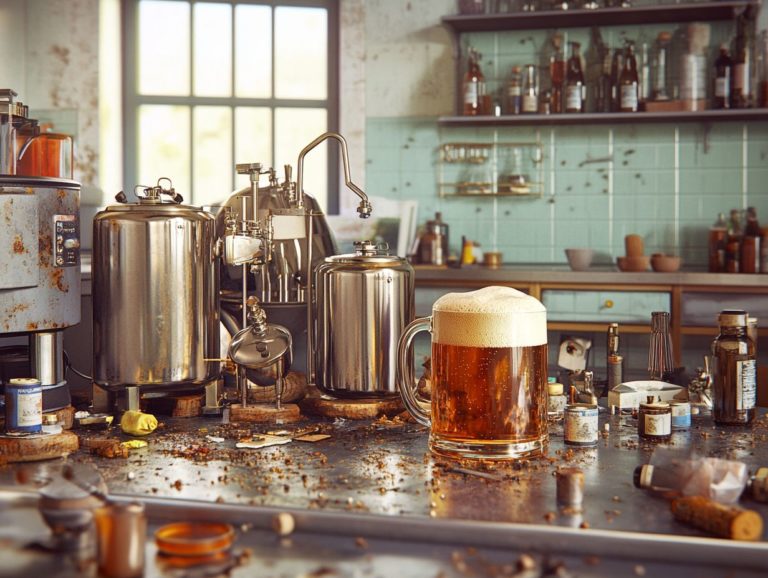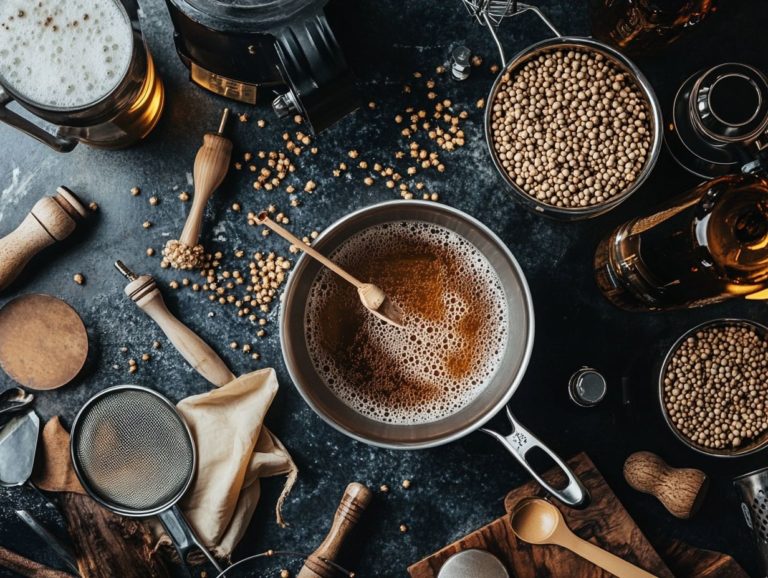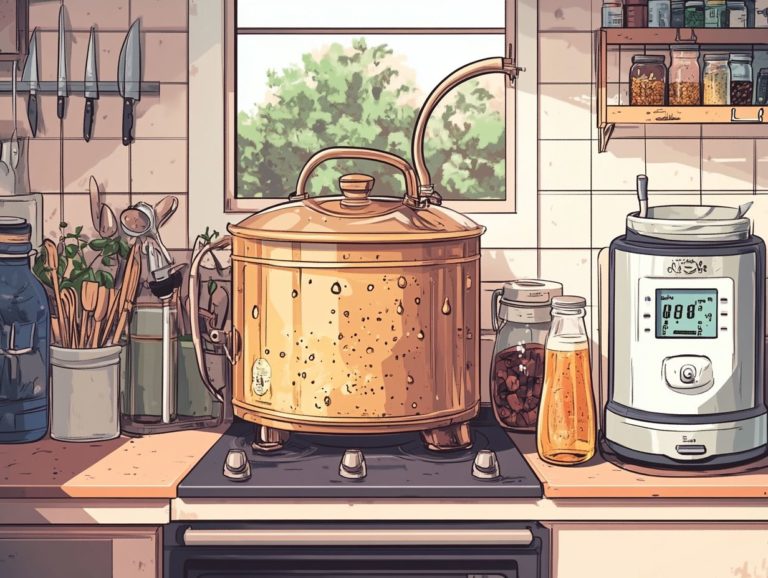What Are the Costs Involved in Home Brewing?
Contents
- Home Brewing: An Exciting Adventure
- Home Brewing Tips for Beginners
Home Brewing: An Exciting Adventure
Home brewing transcends the label of a mere hobby; it invites you on an exhilarating journey into the realm of crafting distinctive flavors and brews, much like the allure of commercial beer.
Whether you re just starting out or seeking to refine your technique, grasping the essential brewing equipment, ingredients, and costs is imperative for effective homebrew setup.
This guide encompasses everything from the basics required to embark on your brewing journey to advanced tools that can elevate your craft to new heights, offering insights into home brewing costs and cost-effective methods.
You will also discover practical tips to save money while fully embracing this rewarding pursuit, including an economic comparison of home brewing versus buying craft beer.
Dive into the thrilling art of home brewing and unlock endless possibilities!
Key Takeaways:
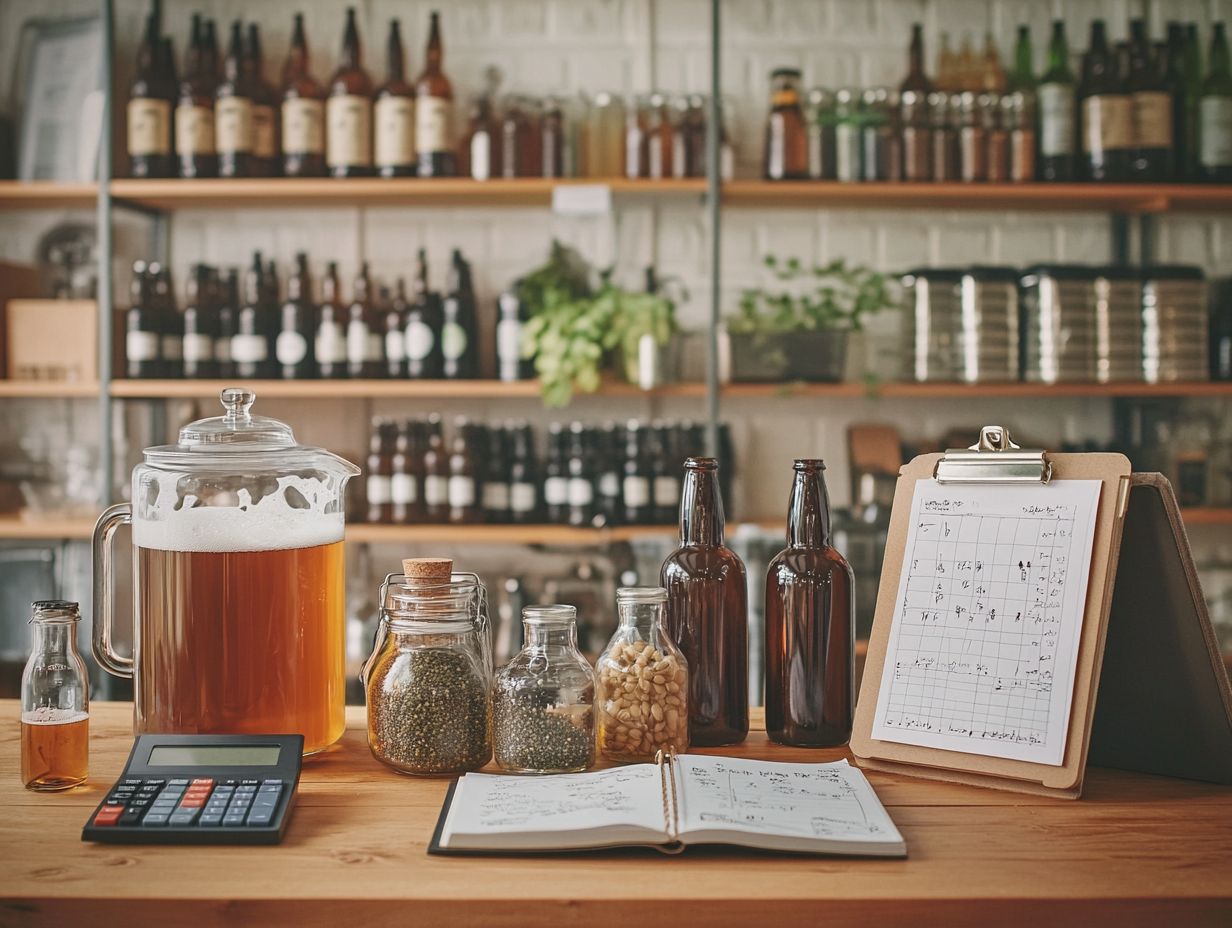
- The costs of home brewing involve both upfront and ongoing expenses, including capital costs and operational costs.
- To save money on home brewing, consider buying ingredients in bulk, reusing equipment, and growing your own ingredients to reduce home brewing costs.
- Joining a home brewing community can also help reduce costs by sharing resources and knowledge.
What Equipment Do You Need for Home Brewing?
Understanding the brewing equipment costs involved can help manage your budget efficiently.
Home brewing is an enriching hobby that invites you to create your own beer, offering a fantastic opportunity to delve into various brewing techniques and styles, while keeping track of home brewing expenses.
As you embark on this creative journey, it’s crucial to familiarize yourself with the essential brewing equipment. This not only affects the quality of your beer but also enhances your overall brewing experience.
By attending events such as Homebrew Con and engaging actively with the brewing community, such as the American Homebrewers Association, you can uncover valuable insights into the finest brewing kits available and the equipment needed for different brewing methods, setting you up for a successful and enjoyable home brewing adventure.
1. Basic Equipment
The basic equipment for home brewing includes essential items such as a brewing kit, containers for fermentation, and measuring tools all vital for crafting your first beer recipe, with the initial homebrew purchase being critical for long-term success.
Having the right setup not only simplifies the brewing process but also elevates the quality of your final product. Your brewing kit should typically contain crucial components, including:
- A brew kettle for boiling malt extract.
- A thermometer to monitor temperatures with precision.
- A hydrometer to measure the density of the liquid compared to water.
Fermentation containers, available in various forms like glass carboys or plastic fermenters, create the ideal environment for fermentation, allowing yeast to transform sugars into alcohol and carbon dioxide, crucial for your fermentation process.
Additionally, measuring tools guarantee that your ingredient ratios are spot on, making all the difference in achieving that perfect flavor profile for your homemade brew.
2. Advanced Equipment
As you gain experience as a brewer, investing in advanced equipment like a kegging system becomes an enticing prospect. This upgrade not only simplifies the complexities of beer storage and carbonating but also cuts down on long-term beer production costs, ushering in a more refined brewing experience.
With this sophisticated setup, you can streamline the transfer of finished beer to kegs while gaining precise control over carbonation levels, enhancing the beer consumption experience.
This level of precision significantly enhances flavor profiles and overall quality.
Plus, consider incorporating specialized fermentation tools, such as temperature-controlled fermentation chambers and high-quality airlocks. These innovations will elevate your brewing process by maintaining optimal conditions for yeast activity, maximizing the potential of various hops and ingredients.
By thoughtfully selecting your brewing equipment and making informed hops purchases, you can unlock a higher quality product that showcases your unique style while ensuring consistency in every batch.
Ready to start brewing? Grab your kit and let the adventure begin!
Optional Equipment
Optional equipment for home brewing has the power to elevate your brewing hobby, providing you with enhanced capabilities like advanced filtration systems and temperature control devices that ensure optimal fermentation.
These tools can have a significant impact on the quality of your final product, giving you the power to experiment with a variety of styles and flavors, maintaining fermentation temperatures as needed.
For example, a refractometer, a tool to measure the sugar levels in your brew, enables you to take precise measurements of sugar content, which helps you fine-tune your recipes with accuracy. Meanwhile, a kegging system streamlines storage and consumption, taking the hassle out of bottling.
Integrating such equipment into your setup not only enriches your brewing experience but also facilitates cost analysis by streamlining various stages, fostering connections within the brewing community.
Both novice and experienced brewers often share valuable insights and techniques, creating an atmosphere of collaborative learning.
Ultimately, these advancements enhance your brewing process and elevate your overall beer consumption experience, transforming you from a home brewer into an accomplished artisan.
What Are the Ingredients for Home Brewing?
The ingredients you choose for home brewing are vital in shaping the flavor, aroma, and overall quality of your final product. Understanding the cost per batch can optimize your homebrew calculations.
It s essential for you to grasp the importance of each component malt, hops, and yeast because they each play a pivotal role in the brewing process.
Your selection of these ingredients directly influences fermentation, opening the door to a myriad of beer production methods and influencing overall beer production costs for you to explore.
Don t miss the chance to create unique recipes that showcase your personal taste and creativity by experimenting with various brewing ingredients and techniques.
Malt
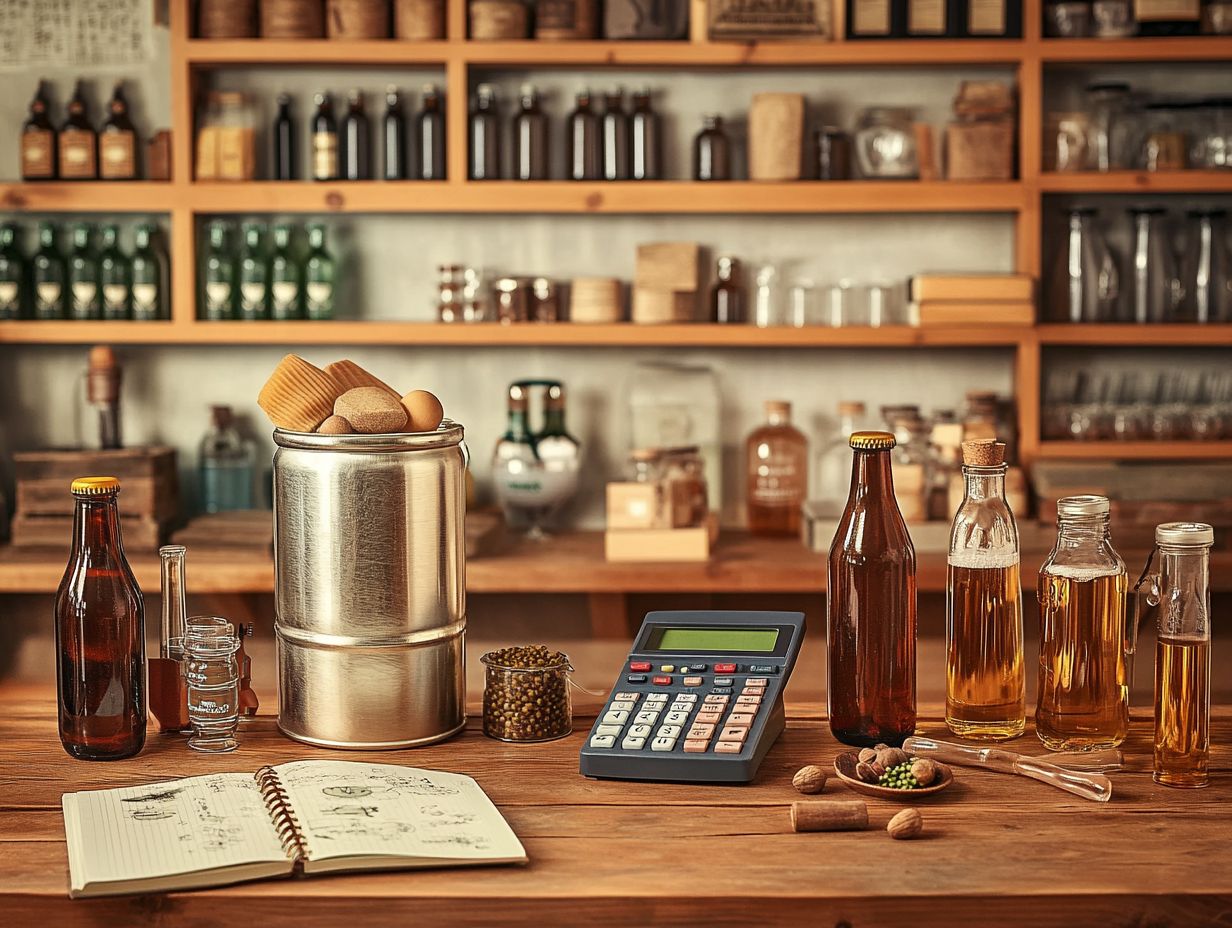
Malt is one of the essential cornerstones of home brewing, providing the important sugars needed for fermentation and shaping the beer s color and flavor profile.
Different types of malt can dramatically influence the entire brewing journey, affecting not just the taste but also the aroma and mouthfeel of the final product.
For example, pale malt acts as the foundation for most beer recipes, delivering a gentle sweetness and a lovely golden hue. In contrast, roasted malts bring a spectrum of shades, from amber to deep brown, infusing rich flavors reminiscent of chocolate or coffee.
Specialty malts, like caramel or crystal malts, contribute complexity, adding sweetness and body to the brew, showcasing the incredible versatility of brewing ingredients.
By grasping these characteristics, you can expertly craft unique beer styles tailored to your specific preferences, ultimately enhancing the entire experience of beer production.
Hops
Hops are an essential ingredient in your home brewing journey, providing not just bitterness, aroma, and flavor, but also serving as a natural preservative that enhances the beer’s shelf life.
Different varieties of hops offer unique flavor profiles that range from floral and citrusy to earthy undertones, significantly impacting the final taste of your brew.
Aroma hops contribute delightful scents that elevate the overall drinking experience, while bittering hops are key to achieving that perfect balance of bitterness to complement the sweetness of the malts.
Choosing the right hops can make or break your brewing success! Get ready to explore the exciting flavors that quality hops can bring. By choosing reputable suppliers, you not only ensure consistent flavor in your beers but also open the door to experimenting with various hop blends. This allows you to craft unique brews that cater to a wide range of taste preferences, making each batch an exciting adventure.
In conclusion, utilizing optional equipment and understanding the ingredients are fundamental to enhancing your home brewing experience. These aspects transform your brewing from a hobby into an art form, allowing you to enjoy the fruits of your labor.
3. Yeast
Yeast serves as the backbone of the fermentation process in your home brewing endeavors. It skillfully transforms sugars from malt into alcohol and carbon dioxide, enriching your beer with delightful flavor and aroma.
Different yeast strains play distinct roles, influencing everything from your brew’s final alcohol content to the complexity of its taste profile. For example, ale yeasts thrive at warmer temperatures, often resulting in a fruity finish. In contrast, lager yeasts prefer cooler conditions, delivering a cleaner taste.
Your choice of yeast shapes the fermentation process and enhances various brewing styles. Whether you’re tackling IPAs, stouts, or saisons, yeast is crucial.
As a home brewer, you have the opportunity to experiment with a range of yeast types. This exploration unlocks unique characteristics in each batch, allowing you to craft customized brews that reflect your individual preferences. Each brewing session becomes a canvas for your artistry.
4. Water
Water is often taken for granted in home brewing. However, it is a vital ingredient that significantly influences the overall quality and taste of your beer.
This influence largely depends on its mineral content. You cannot underestimate the importance of water quality. It plays a fundamental role in the brewing process alongside other essential ingredients.
The composition of your water, including its pH level and mineral makeup, can either enhance or detract from the flavors of the malt and hops in your brew. For instance, higher sulfate levels, which affect bitterness, can bring out hop bitterness, while a softer water profile may lend itself to a rounder, malt-forward character.
Dive into the exciting world of water characteristics to enhance your brew! By understanding these factors, you can tailor your brews to achieve your desired flavor profile, leading to a more enjoyable and unique drinking experience.
5. Other Additions (Fruit, Spices, etc.)
As a home brewer, you have the exciting opportunity to experiment with a variety of additions like fruits, spices, and herbs. These ingredients craft unique beer recipes that elevate both flavor and aroma, much like commercial beer producers do.
These ingredients are essential in shaping the character and complexity of your final brew. For example, citrus fruits such as oranges and lemons can add a refreshing zest. Meanwhile, spices like cinnamon or coriander introduce warmth and depth to your creation.
Your creativity truly shines through these choices. You can tailor recipes that reflect seasonal influences or your personal tastes. By thoughtfully selecting your brewing ingredients, you can strike a perfect balance between sweetness and bitterness, crafting layered taste experiences that surprise and delight fellow beer enthusiasts, much like in craft beer.
This spirit of innovation is what makes the art of brewing so exhilarating.
What Are the Costs Involved in Home Brewing?
Understanding the costs associated with home brewing is crucial for aspiring brewers. This includes both the capital expenses linked to the initial setup and the ongoing operational costs that arise during the brewing process.
Conducting a comprehensive cost analysis provides valuable insights into the overall investment necessary for producing brewing batches. This approach enables you to effectively manage your homebrew setup and maximize savings on brewing equipment costs.
1. Upfront Costs
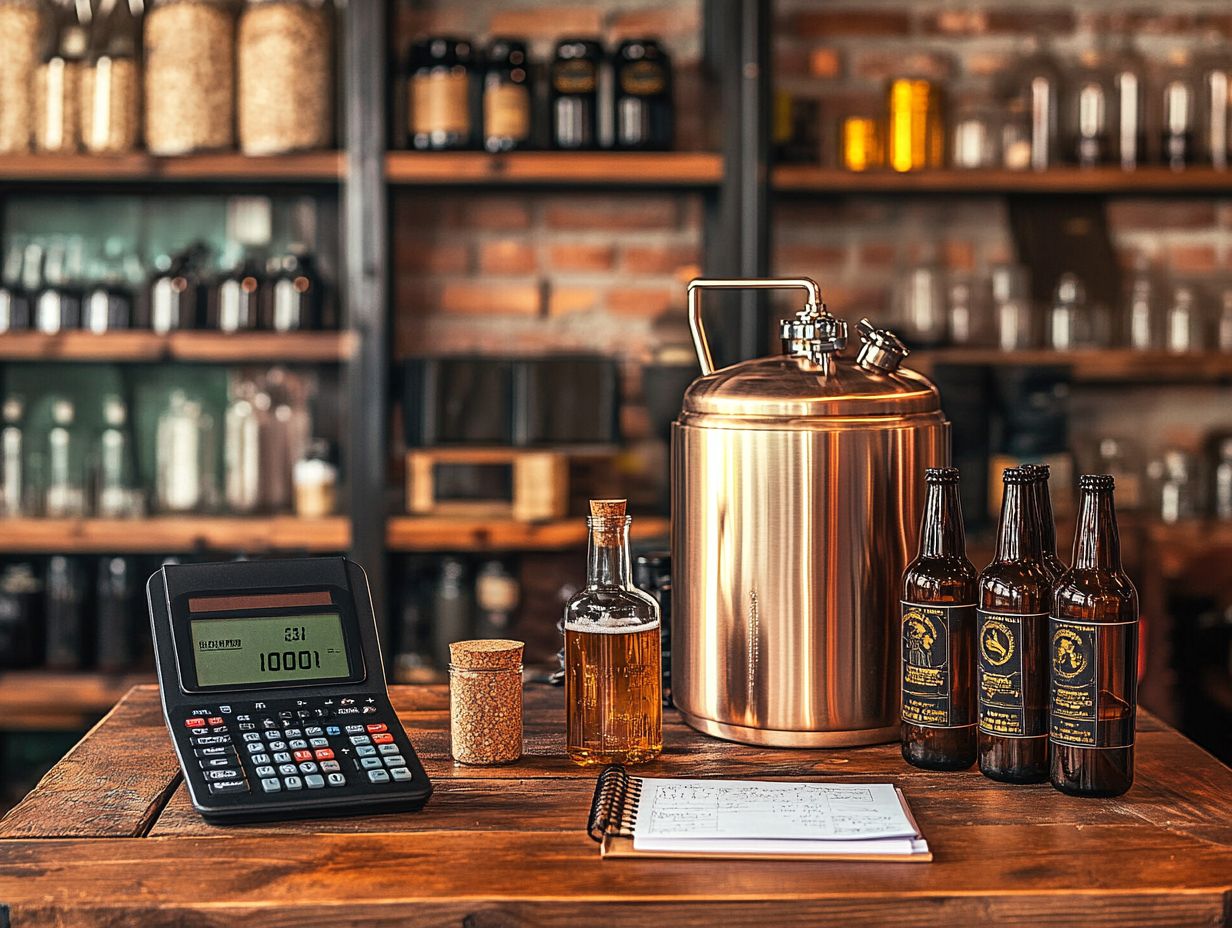
When you embark on the journey of home brewing, it is essential to consider the initial costs associated with acquiring the necessary equipment. This includes expenses for items like a brewing kit, fermentation vessels, and bottling or kegging systems each critical for cultivating this enriching hobby.
Your initial investment can vary significantly, typically ranging from a few hundred to over a thousand dollars based on the quality and size of the equipment you choose. A basic brewing kit may cost around $100 to $200. However, opting for more advanced setups featuring larger fermentation vessels and sophisticated temperature control systems can greatly enhance both your brewing experience and financial commitment.
It is also crucial to factor in ongoing expenses related to your brewing operations. Ingredients, sanitizers, and various supplies contribute to the sustainability of your brewing endeavor, ensuring that you maintain a successful operation over time, including items like StarSan.
2. Ongoing Expenses
The ongoing expenses associated with home brewing encompass the recurring costs tied to producing each brewing batch. These include sourcing ingredients, purchasing water, and acquiring yeast, which can vary significantly based on the brewing techniques you employ.
In addition to these essential components, you will find that home brewing expenses can also cover the costs of hops, specialty grains, and a variety of flavoring agents. These elements greatly impact the quality and uniqueness of your final product. You will find that making a hops purchase in bulk can be a cost-effective strategy.
Utility costs add up quickly. Consider water usage, electricity for heating, and sometimes gas for outdoor setups all of which should be factored into your overall homebrew costs.
Regular maintenance of your brewing equipment also plays a vital role in your financial considerations. From sanitizing your gear to replacing worn-out components, these routine expenditures are crucial for ensuring that each batch not only meets your expectations but also helps you refine and elevate your brewing craft over time, similar to the meticulous fermentation process in commercial beer production.
How to Save Money on Home Brewing?
You can achieve significant savings on home brewing by employing a range of effective strategies. Consider purchasing ingredients in bulk, reusing equipment, and tapping into the wealth of knowledge and resources available within the home brewing community.
By embracing these cost-effective methods, you will not only reduce your homebrew expenses but also enhance your experience as you craft unique and delightful beers.
1. Buy in Bulk
Buying ingredients in bulk is one of the smartest strategies for saving money on home brewing. It significantly reduces the cost per batch while ensuring you have a steady supply of the essential components.
This approach leads to substantial savings on your homebrew expenses and streamlines the ingredient-sourcing process. Imagine the convenience of knowing you have everything you need at your fingertips, allowing you to bypass those frantic last-minute trips to specialty stores when gearing up for a brewing session.
When you purchase in larger quantities, you’re often able to choose higher-quality ingredients. Suppliers tend to offer better deals on bulk orders, which means you can indulge your passion for brewing without constantly worrying about running low on vital components. This not only enhances your brewing experience but also opens the door to experimenting with various recipes, elevating your craft to new heights and exploring different brewing styles.
Don’t miss out on these money-saving tips to enhance your brewing journey!
Home Brewing Tips for Beginners
2. Reuse Equipment
Reusing equipment is a savvy strategy for home brewers. It allows you to minimize costs while enhancing your brewing experience. By doing this, you can significantly lower your brewing equipment expenses over time, including the costs associated with keg storage.
Maintaining and repurposing tools like fermenters, kegs, and tubing keeps your setup running smoothly and elevates the overall quality of your brews. Regular cleaning and sanitizing these items is crucial to prevent cross-contamination and ensure your flavors are at their peak.
Thinking outside the box with old equipment can ignite your creativity. For example, a retired keg could transform into a striking outdoor planter or a clever storage solution. Embracing these practices promotes a sustainable brewing culture and enables you to channel more resources into high-quality ingredients instead of equipment for your homebrew setup, fostering homebrew savings.
3. Grow Your Own Ingredients
Growing your own ingredients, like hops, is a rewarding way to cut costs in home brewing while elevating the freshness and quality of your beer. This practice also lowers your annual costs for hops purchases.
By cultivating hops, you can significantly reduce the need for frequent hops purchases that can strain your budget. Plus, you can enjoy peace of mind knowing your ingredients are organic and free from pesticides.
For those immersed in the brewing community, sharing your homegrown hops fosters friendship with fellow brewers and ignites creativity for unique recipe experiments. Homegrown hops deliver an unmatched flavor profile, resulting in a brew that is more aromatic and rich in flavor a true hit among friends and family.
In essence, growing hops is not merely an economical choice; it s also a delightful way to deepen your connection to the brewing craft, akin to how hops purchases impact larger beer production methods.
4. Join a Home Brewing Community
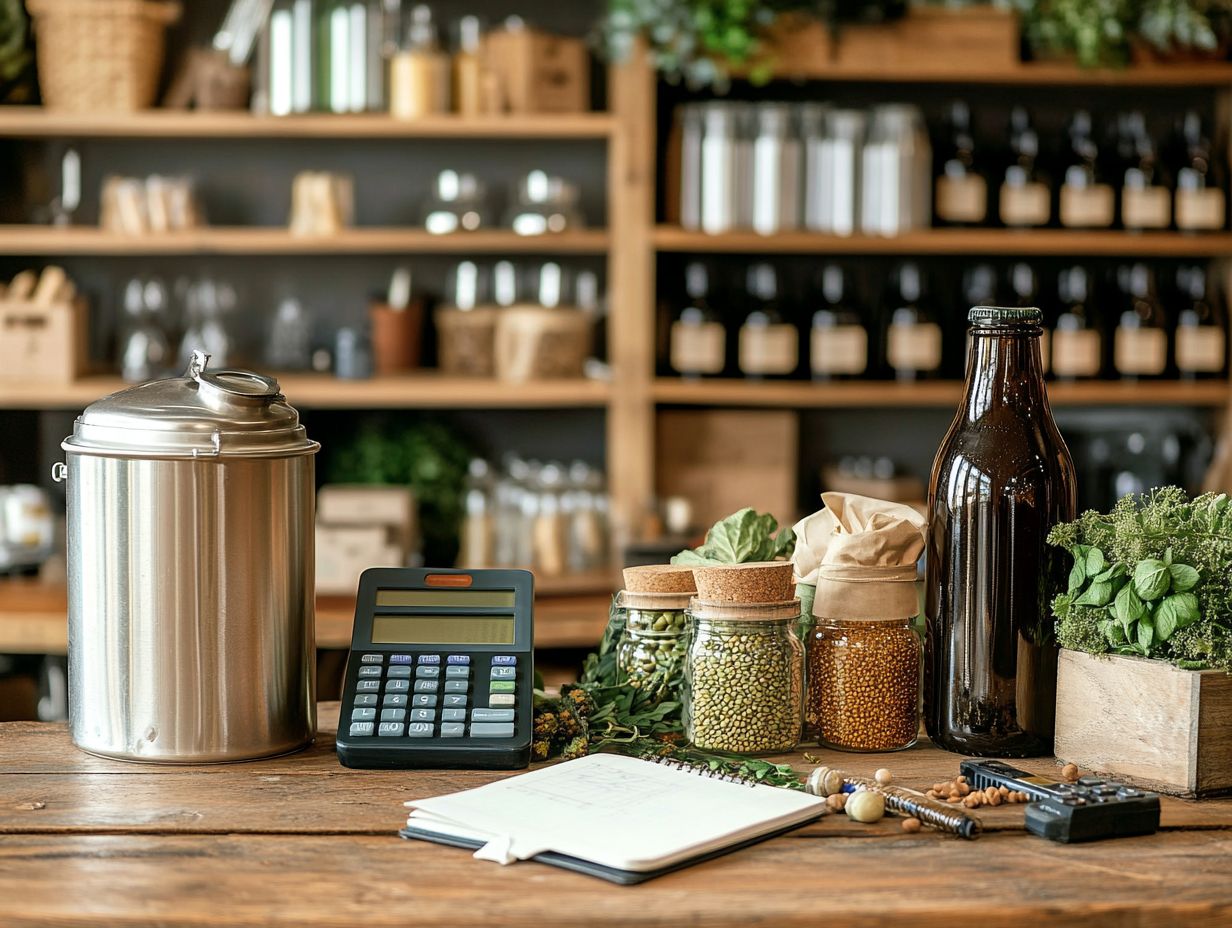
Joining a home brewing community presents you with invaluable opportunities to network, share experiences, and gain insights that elevate your brewing endeavors while helping you save on costs. Participating in homebrew events like Homebrew Con enhances your learning and connections.
Being part of this vibrant community allows you to connect with fellow enthusiasts who share your passion for crafting unique beers. You ll find yourself attending homebrew events where you can showcase your creations and sample a variety of styles, gaining inspiration and acquiring new techniques to refine your craft.
Engaging in knowledge-sharing initiatives through workshops or online forums gives you access to a treasure trove of information about ingredients and brewing methods. This collaborative atmosphere nurtures creativity and skill development, leading not only to better brews but also to a more enjoyable brewing journey. You might even learn new brewing techniques or the latest homebrew trends.
Frequently Asked Questions
What Are the Costs Involved in Home Brewing?
Home brewing costs can vary, but let s break down what you can expect. The costs involved vary depending on factors such as equipment, ingredients, and frequency of brewing. However, on average, a basic home brewing setup can cost between $100 and $200.
Do I Need to Buy Expensive Equipment to Start Home Brewing?
No, you can start home brewing with a basic setup that includes a fermenter, hydrometer, and bottling equipment. As you gain experience and want to expand your brewing capabilities, you can invest in additional equipment such as a kegging system.
What Ingredients Do I Need to Buy for Home Brewing?
The main ingredients for home brewing are water, malt extract, hops, and yeast. These can be purchased from a local brewing supply store or online. You may also choose to add specialty grains or flavorings, which will increase the cost. Don’t forget to include sanitizer to maintain equipment cleanliness.
Conclusion
In summary, reusing equipment, growing your own ingredients, and joining a home brewing community can significantly improve your brewing experience while saving costs. Embrace these practices and enjoy the journey of crafting your home brew!
How much does it cost to brew a batch of beer at home?
The cost of brewing a batch of beer at home typically ranges from $20 to $50. This depends on the type of beer and the ingredients used.
Brewing at home is more cost-effective than buying the same amount of commercial beer from a store.
Are there any ongoing costs involved in home brewing?
Yes, there are ongoing costs in home brewing. These include ingredients for each batch, the purchase of hops, and occasional equipment replacements.
Costs for items like sanitizer and various types of yeast also add up.
Can I save money by home brewing instead of buying beer from a store?
Absolutely! Home brewing not only saves you money but also opens doors to endless creativity.
The initial costs for equipment might seem high, but the price per batch is much lower compared to store-bought beer.
You ll also get to experiment with different brewing styles and create your own unique brews. Joining communities like the American Homebrewers Association can help reduce costs with shared resources and events.


